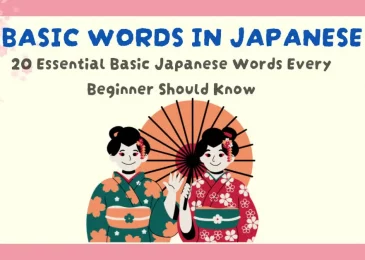Why Beginners Need to Learn Japanese Numbers?
You will improve Japanese communication. Understanding Japanese numbers enhances your ability to communicate effectively. Numbers are crucial in daily activities: when ordering food or asking for directions, telling time, and discussing prices. Mastering Japanese numbers boosts your confidence in everyday interactions with locals. Besides, learning Japanese numbers enriches your understanding of Japanese customs. For example, the Japanese number 4 (四, shi) is avoided due to its association with death.
How do you count from 0 to 10 in Japanese?
It’s important to understand the basic Japanese numbers from 1 to 10 before moving on to larger ones. Here’s a quick reference:
If you know these simple Japanese numbers, you will be better prepared to deal with bigger amounts and more complex Japanese phrases.
- Are there different ways to say zero in Japanese?
In Japanese, the Kanji character for zero is 零 (rei). When discussing the Japanese number 0, Japanese people typically use one of two pronunciations: ゼロ (zero), which is borrowed from English, or マル (maru), which means “circle.”
- Why Do Japanese Numbers 4, 7, and 9 Have Two Readings?
The Japanese numbers 4, 7, and 9 have unique characteristics due to their phonetic similarities with words that have negative connotations.
- Number 4: The Kanji for 4 is 四, which can be pronounced as し (shi). However, this pronunciation sounds like the word for “death” (死, shi), leading many Japanese people to avoid using it in certain contexts, such as in elevators, room numbers, or when giving gifts. Instead, they often use the pronunciation よん (yon) or よ (yo) to prevent bad luck.
- Number 9: The Kanji for 9 is 九, pronounced as く (ku), which is similar to the word for “suffering” (苦, ku). Due to this association, the pronunciation きゅう (kyuu) is more commonly used to avoid any negative implications.
- Number 7: While the number 7 is considered lucky in Japanese culture, it can be pronounced as しち (shichi), which includes the sound “shi.” To steer clear of this phonetic resemblance to “death,” people often use the pronunciation なな (nana) instead.
Understanding these nuances helps you grasp the cultural significance behind Japanese numbers, making it easier to navigate conversations and contexts where they appear.
How do you count from 11 to 99 in Japanese?
- Counting from 11 to 19
Now, let’s move on to counting from 11 to 19 in Japanese. To form these numbers, you simply say the word for ten (じゅう, juu) followed by the additional Japanese number needed to reach the total. Think of it like a simple math equation.
For instance, じゅういち (juuichi) is created by combining じゅう (juu) with いち (ichi), as 11 is equal to 10 plus 1. So, you can think of it as:
10 + 1 = 11 or じゅう + いち = じゅういち.
Here’s how it works:
- 11: 十一 (juu-ichi)
- 12: 十二 (juu-ni)
- 13: 十三 (juu-san)
- 14: 十四 (juu-yon or juu-shi)
- 15: 十五 (juu-go)
- 16: 十六 (juu-roku)
- 17: 十七 (juu-nana or juu-shichi)
- 18: 十八 (juu-hachi)
- 19: 十九 (juu-kyuu or juu-ku)
Note: There are two readings for the numbers 14, 17, and 19. However, じゅうよん (juuyon), じゅうなな (juunana), and じゅうきゅう (juukyuu) are more commonly used than じゅうし (juushi), じゅうしち (juushichi), and じゅうく (juuku).
- Counting from 20 to 99 in Japanese
The same rules apply when counting from 20 to 99. Start with the multiples of ten that end in zero, such as 20, 30, and 40,… For these Japanese numbers, you simply say the first number followed by じゅう (juu).
To form additional numbers, like 21 or 22,… you can add the units. For example, 21 is made up of 20 plus 1, so you combine にじゅう (nijuu) and いち (ichi) to create にじゅういち (nijuuichi).
Therefore, you can think of it as:
20 + 1 = 21 or にじゅう + いち = にじゅういち.
What are the Japanese numbers from 100 and beyond?
As you dive deeper into the Japanese language, understanding how to count in the hundreds and thousands becomes essential. This guide will help you navigate the counting system of Japanese numbers from 100 to 10,000 with ease.
- Counting from 100 to 999
In Japanese, the number 100 is written as 百 (ひゃく, hyaku). To express numbers from 200 to 900, you simply combine the first digit with 百. Here are some examples:
Note that the pronunciation of 百 changes for certain numbers. Specifically, 300 is pronounced as さんびゃく (sanbyaku), 600 as ろっぴゃく (roppyaku), and 800 as はっぴゃく (happyaku).
To form more complex numbers, such as 345, combine the components: 三百四十五 (さんびゃくよんじゅうご、 sanbyaku yonjuu go).
- Counting from 1,000 and Beyond
The number 1,000 in Japanese is represented as 千 (せん、 sen). As you progress to larger Japanese numbers, here are the key figures.
- 10,000: 一万 (いちまん, ichiman)
- 100,000: 十万 (じゅうまん, juuman)
- 1,000,000: 百万 (ひゃくまん, hyakuman)
- 10,000,000: 千万 (せんまん, senman)
- 100,000,000: 億 (おく, oku)
What are the most common Japanese counters for people,paper, and things?
Japanese counters are crucial for accurately counting objects, people, and time in the language. Familiarizing yourself with these counters will enhance your communication skills. The Japanese will have counting units that match the form of the thing. Here are some essential Japanese counters, along with special notes for particular cases:
- 人 (にん、 nin) – Used for counting people. For one person, use 一人 (ひとり, hitori) and for two people, use 二人 (ふたり, futari).
- 本 (ほん, hon) – Used for counting long, cylindrical objects like bottles or pens. The pronunciation changes based on the number: 1 (一本, いっぽん, ippon), 6 (六本, ろっぽん, roppon), and 8 (八本, はっぽん, happon).
- 枚 (まい, mai) – Used for counting flat objects such as sheets of paper or plates.
- つ (つ, tsu) – A general counter for various objects, often used for counting items up to ten. This counter is unique because it has different readings for numbers 1 to 10. One object is expressed as 一つ (ひとつ, hitotsu), while two objects become 二つ (ふたつ, futatsu). Three objects become 三つ (みっつ, mittsu), four as 四つ (よっつ, yottsu), and five as 五つ (いつつ, itsutsu). Six objects take the form 六つ (むっつ, muttsu), seven as 七つ (ななつ, nanatsu), eight as 八つ (やっつ, yattsu), and nine as 九つ (ここのつ, kokonotsu). Especially, Ten objects use 十 (とお, tō) and do not utilize the つ (tsu) counter.
- 回 (かい, kai) – Counter for Occurrences. As with other counters, certain numbers have unique readings, such as 一回 (いっかい, ikkai) for “one time.”
How can I memorize Japanese numbers quickly and effectively?
- Practice regularly:
Consistent practice is key to mastering Japanese numbers. Set aside time each day to review and practice counting. Writing and exercise to reinforce your memory. The more you practice, the more confident you will become in using numbers in conversations.
- Listen to native speakers:
This is a great way to improve your pronunciation and accent. Pay attention to how they pronounce numbers in different contexts. You can find resources, such as language podcasts or YouTube videos, that focus on Japanese numbers. This exposure will help you develop a more authentic accent and better understanding of the language.
- Use Language Apps:
You will have a fantastic resource for mastering Japanese numbers when using apps for learning Japanese. One such app is MochiKanji, which offers interactive lessons and exercises focused on numbers and other vocabulary. With MochiKanji, you can practice recognizing, reading, and writing Japanese numbers in an enjoyable way. The flashcard system helps reinforce your learning, ensuring that the numbers stick in your memory. Incorporating this app into your daily routine can significantly boost your confidence in using Japanese numbers.
Conclusion
Grasping the importance of essential Japanese numbers and counters is vital for successful communication. Regular practice of these counters, along with their specific cases and readings, will greatly improve your language abilities. By integrating Japanese numbers and counters into your daily routine, you’ll become more comfortable and confident in conversations. Embrace these tools to elevate your Japanese skills and enhance your interactions!









